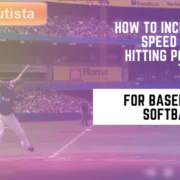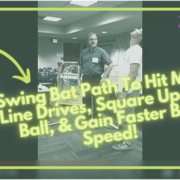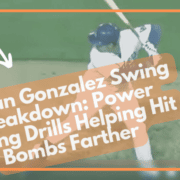Faster Bat Speed Hitting Training Drills For Youth Baseball & Softball Power | Ted Williams & Matt Kemp Swing Analysis Breakdown
Learn how to get faster bat speed with these hitting training drills for more youth baseball and softball power. Discover the increase bat speed secret in this Ted Williams and Matt Kemp swing analysis breakdown.
Matt Kemp: Unique Ted Williams Power Secret
Imagine if I asked you to take a ride in my 2-year-old son’s favorite sports car and ultimate luxury vehicle, the Lamborghini Aventador…cherry red.
Costs about $400K, has 720 horse-power, and goes zero to sixty-mph in 2.8 seconds. I’m drooling just thinking about it. What if I also told you it had no brakes. The manufacturer just “forgot” to install them. If you know I have a lead foot, then would you still want a ride?
I tell my hitters that someone like Matt Kemp or Ted Williams are using both rotational and anti-rotational systems during the swing.
Think of them as acceleration and braking systems, and both are important to a friction-free swing. Our focus today will be optimizing these systems during the stroke. We’re going to highlight:
- The science of accelerating & braking systems,
- Matt Kemp & Ted Williams (who has the more efficient braking system?)
- How to tune-up your acceleration & braking system.
SCIENCE-BASED TRAINING:
Improve your hitting strategy dramatically by applying human movement principles.
Learn not only how and what to train but also the science behind the methods.
The Science of Accelerating & Braking Systems
Thomas Myers in his book Anatomy Trains talks about 9 different fascial lines found throughout the body that inter-weave and inter-relate during human movement. We’ll be highlighting one in particular called the Functional Lines (pictured right). CLICK HERE for a brief background on springy fascia.
Thomas Myers says that Functional Lines mainly come into play in the following athletic events:
- Shot Put, Javelin, Discus, and Hammer Throws,
- Tennis,
- Golf, and of course
- For hitters like Matt Kemp & Ted Williams
Thomas Myers says,
“These lines enable us to give extra power and precision to the movements of the limbs by lengthening their lever arm through linking them across the body to the opposite limb in the other girdle.”
Imagine a big “X” painted on your chest and back, connecting the right shoulder to the left hip, and vice versa. Thomas Myers refers to them as Front Functional Lines (FFL) & Back Functional Lines (BFL). He uses a couple different examples to illustrate the braking system in action:
“Pitching a baseball or bowling a cricket are perfect ways to engage these lines: the wind-up involves a shortening of the BFL and a stretching of the FFL, while the pitch itself reverses that process, shortening the FFL and stretching the BFL. In the final act, the BFL acts as a brake to keep the strong contraction along the FFL and the momentum of the arm from going too far and damaging joints involved in the movement.”
You still following me? It’s okay if not. We’ll simplify in the next section…
Matt Kemp & Ted Williams (who has the more effective braking system?)
I want to compare Matt Kemp to Ted Williams because they have similar body types, according to Baseball-Reference.com:
- Matt Kemp – 6’4″, 215-pounds
- Ted Williams – 6’3″, 205-pounds
Simplifying the acceleration/braking systems, we can just follow the front shoulder to see who is being more efficient with their Functional Lines. Consider Ted Williams:

Follow yellow arrows tracking Ted Williams’s front (right) shoulder path…photo left to right: 1) Down, 2) Up, and 3) Down again.
Now, check out the difference with Matt Kemp:

Follow yellow arrows tracking Matt Kemp’s front (left) shoulder path…photo left to right: 1) Slightly Down, 2) Up, and 3) Up again.
That’s right, Matt Kemp finishes with his left shoulder up! Not convinced? Check out the photo of his finish at the beginning of this post. He’s not being very efficient with his braking system. Matt Kemp is leaving repeatable power on the table (which is scary!)…to polish, he’d have to:
- Get more downhill shoulder angle before landing,
- Show more of his numbers to the pitcher, and
- Focus on finishing “barrel down” with his top hand release.
How-to Tune-Up Your Acceleration & Braking Systems
There are a couple quick exercises and stretches that Thomas Myers recommends to tune-up both Functional Lines:
- Engage BFL (Alternating Supermans) – 2 sets X 12 reps each side. Focus on moving the body as a whole. Arm and leg are to be lifted at exactly same time. Head stays in line with spine. Don’t arch head back like in video.
- Engage FFL (Alternating Supermans) – same as #1, but do Alternating Supermans on your back.
- Stretch BFL (Triangle Yoga Pose) – Hold position on each side for a deep breath count of 5-10.
- Stretch FFL (1/2 Kneeling Hip Flexor Stretch w/ Rotation) – hold position on each side for about 60-seconds. Keep the abs and “down knee” glute contracted during stretch.
Do the above four 1-2 times daily for 3-weeks.
- Fix Your Child’s Fear of the Ball Fast: Proven Hitting Drills to Stop Flinching at Pitches—Trusted by Top Youth Baseball Coaches - July 12, 2025
- Fix Your Little Leaguer’s Hitting Slump Fast – Proven Confidence Drills & Mental Reset Tools (Used by Top Youth Baseball Coaches) - July 9, 2025
- Best Hitting Drills for 8-Year-Olds (2025): Fix Swing Flaws Fast with This MLB-Trusted Youth Baseball System—At-Home, Step-by-Step, and Built for Game-Day Confidence - July 5, 2025













Joey – thanks again – great response to my last comment. Two observations:
1) You description of ‘barrel down’ at finish is perfect – my local ‘pros’ can’t figure this out.
2) Ted Williams hips are awesome – that relates the Chas’ superthrust – Do you have any comments on how that could generate more power for Kemp without any sacrifice?
always great to review,
steve
Steve, I know the one-handed release came about through the Charlie Lau philosophy. I always liked the way it made me feel like I was getting through the ball. As long as this kind of hitter understands that the barrel must finish low, they optimize the finishing movement (braking system).
Aside from Kemp not being as efficient with his Accel/Brake Systems, he arm bars as well. The “super-thrust” thing has to do with bending the back knee during the Final Turn. By “skipping” the back foot slightly forward during the turn, Kemp will get a better pitch-plane angle, better hip turn, and keep the head still.
What’s scary is Kemp has an over .350 Batting Average on Balls In Play (BABIP) after 9 years of MLB experience. This loosely measures how hard a hitter hits the ball. I think the elements I mentioned in the video/blog post will significantly boost his repeatable power. I hope this answers your questions Steve.
Ted Williams is my B-O-A-T, in my opinion if you’re following the best, disregarding several others isn’t all bad. Along that same thought and what he says in his book, unless you’re Mickey forget the other side, imagine the work you double on the dominate hand without switching. I’ve wondered why Ruth, DiMaggio, Williams all looked like a twisted washrag on follow through. You’ve put it in perspective for me here.
I had to do it in order to think about it. It seems that the one handed follow through creates the high back shoulder. A ton of pros to kids use it. When I kept both hands on it made the high front shoulder simple. When you freeze with the high back shoulder and slowly transition to a high front, there’s about 6 inches of swing left. I immediately worried about the outside pitch however. Turns out you can still get to it by doing what I call ‘following the ball with your hands’ into the two-handed, high front shoulder. (I harp on my kid about keeping both hands on the bat, a lot disagree.). The question for me remains, how much impact does the follow through have on a batted ball? (We’ve all seen Fraizer hit it out with no hands, and Harper break a bat and it still fly out of the ballpark.). Maybe you or Sports Science can do a piece on it. 😉 Great realizations here, thank you for the post!
My pleasure Bill, and you raised a lot of great points here. I don’t teach all my hitters to a 2-hand finish, but I do encourage it. Fixes quite a few things that can be thorns on the journey to an effective swing. Physics says a hitter can let go of the bat just before impact, and nothing changes with force production. However, biomechanics says directional force matters. A 2-handed finish helps with the latter, and like you said helps to safely decelerate the spinal engine and springy fascia.
Joey,
Got into a discussion the other day as to the definition of “landing.” In regard to the downward shoulder angle, are we differentiating between landing and heel plant? They are not the same, correct? In other words, is the front shoulder at a downward angle at landing (toe/ball of foot touch) and at heel plant? Or, is the front shoulder down at landing and, then, begins to shift upward at heel plant due to the ground force travelling up the kinetic chain? Is the front shoulder still angled down at heel plant?
I think that’s splitting straws there, whether down shoulders are down at toe touch or heel plant. I will say that before the hitter begins turning, the shoulders better initiate from a downhill position.
Joey,
Heel plant, not toe touch, results in ground reaction force travelling up the proverbial kinetic chain. It happens very fast. If the front shoulder is still down the hitter’s timing is off. Once again it’s semantics but it would be wise to distinguish between toe touch and heel plant. The heel plant stops all of the actions that preceded it, transforming them into something different. We are talking about instructing kids, right? What is landing to them, toe touch or heel plant? I would think that defining each movement of the sequence would benefit those we are instructing.
Of course, “variance” in the timing of the move is highly recommended. However you have to teach it to get the end result. The heel strike isn’t a hard action, it’s a soft action…landing toe (or ball of foot) first is crucial to this. Achilles tendon helps to cushion the heel strike. So depending on the timing of the hitter, too late/too early/or on time will vary if down shoulders switch earlier or later. Timing is the “X” factor in the equation, that’s why training variance is key. Get hitters to feel/do all available options and scenarios.
Joey,
That’s what I’m saying. Just distinguish between toe touch (“landing”) and heel plant. I was told that Ted Williams wasn’t aware of the significance of the heel drop. He landed kind of flat footed.
Yeah, what I look for is a soft landing on toe, ball of foot, or mid strike…NO HEEL landings. There’s a lot of adjustment to the swing that can be had.
Mantle landed flat footed as well. Is the heel drop/plant a recent phenomenon, then?
Epstein’s teachings made this a thing. In the grand scheme, it’s irrelevant, unless the hitter is landing heel first.
Joey,
I think it’s relevant.
That heel plant gets the ground reaction process started (yes, the spinal engine starts everything). Epstein’s stuff came out in the ’90s. The first hitter I noticed with a pronounced heel drop was Albert Pujols. I don’t think he was a devotee of the Epstein hitting system, though.
But Joe, the heel drop isn’t a teach. I NEVER teach it, unless like I said, the hitter is landing heel first. Ground reaction forces are only 20-30% of power. When we walk, we don’t think about heel drop, we just do it. Hitting should be the same.
Joey,
But when we walk, we don’t land on the ball of our feet. It’s the heel that we land on, no?
I like to teach foot strike and then heel plant to demonstrate a sequential summation of movement. Then, I put it all together. Getting the player to bend his knee is part of the reason. Then, to teach them the braking effect of the heel plant. I believe that you use your “Break It Apart” drill for that purpose?
On walking, if intent is to assertively walk, heel strike is first, but if intent is to tentatively walk, then ball of foot or toe would be first. Hitting is more like the latter example. Break it Apart drill is awesome for phasing the swing when teaching. I don’t like teaching hitters to land toe first and early, read, then drop heel and swing. Hitters may have a tendency to create a false double stride. I have one of my hitters – because of a bonehead High School coach – use a leg kick, set foot down, then transition into a Paul Goldschmidt style wide no-stride hip slide. We cut out the slide when he’s 0 or 1 strike, and use the slide ONLY when he has 2-strikes. Gotta trim the timing fat.
I might break it apart a little more but put it all together with it all happening almost simultaneously. No separate movements that would interrupt the forward momentum. None of the “foot down early” stuff. That confuses more kids than any cue I have ever heard.
Not a fan of Goldschmidt’s swing.